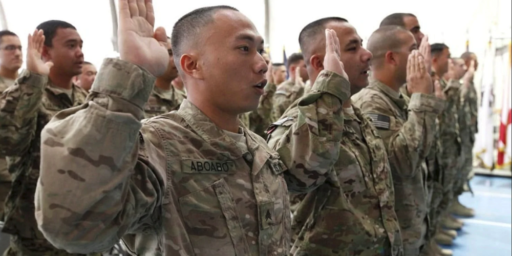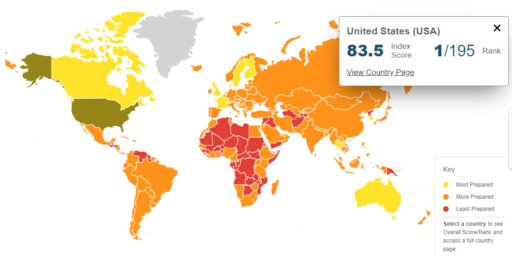Military Strained Not Broken
A joint study of field grade officers by Foreign Policy and the Center for a New American Security finds that the toll of two wars has been a major strain on the American military but that it is not broken and morale remains high.
These officers see a military apparatus severely strained by the grinding demands of war. Sixty percent say the U.S. military is weaker today than it was five years ago. Asked why, more than half cite the wars in Iraq and Afghanistan, and the pace of troop deployments those conflicts require. More than half the officers say the military is weaker than it was either 10 or 15 years ago. But asked whether “the demands of the war in Iraq have broken the U.S. military,” 56 percent of the officers say they disagree. That is not to say, however, that they are without concern. Nearly 90 percent say that they believe the demands of the war in Iraq have “stretched the U.S. military dangerously thin.”
The health of the Army and Marine Corps, the services that have borne the brunt of the fighting in Iraq, are of greatest concern to the index’s officers. Asked to grade the health of each service on a scale of 1 to 10, with 1 meaning the officers have no concern about the health of the service and 10 meaning they are extremely concerned, the officers reported an average score of 7.9 for the Army and 7.0 for the Marine Corps. The health of the Air Force fared the best, with a score of 5.7. The average score across the four services was 6.6. More than 80 percent of the officers say that, given the stress of current deployments, it is unreasonable to ask the military to wage another major war today. Nor did the officers express high confidence in the military’s preparedness to do so. For instance, the officers said that the United States is not fully prepared to successfully execute such a mission against Iran or North Korea.
A majority of the officers also say that some of the policy decisions made during the course of the Iraq war hindered the prospects for success there. These include shortening the time units spend at home between deployments and accepting more recruits who do not meet the military’s standards. Even the military’s ability to care for some of its own—mentally wounded soldiers and veterans—was judged by most officers to be substandard.
These negative perceptions, however, do not necessarily translate into a disillusioned or disgruntled force. Sixty-four percent of the officers report that they believe morale within the military is high. Still, they are not without concern for the future. Five years into the war in Iraq, for example, a majority of the officers report that either China or Iran, not the United States, is emerging as the strategic victor in that fight. In an era when the U.S. military is stretched dangerously thin, it’s a sign that the greatest challenges may still lie ahead.
This isn’t particularly surprising. The post-Cold War force was designed to fight “two nearly simultaneous wars,” with one of them being a Desert Storm-type mission. We’re now fighting two long, sustained efforts and managing dozens non-combat around the world besides.
We haven’t adjusted the force or our mission posture accordingly. Partly, this is a function of the fact that few believed both Afghanistan and Iraq would need such a major commitment half a decade into those operations. Partly, it’s a function of a political-bureaucratic incentive structure that prioritizes the acquisition of new weapons systems rather than an investment in personnel.
Regardless, we’ll soon have to make a hard choice: A larger force or a smaller demand on the existing force. We can’t keep up the present pace indefinitely.
This is also interesting:
Many proposals have been suggested to help the military meet its recruiting and retention needs. But an incredible percentage of the index’s officers favor the same solution: Nearly 80 percent support expanding options for legal, foreign permanent residents of the United States to serve in exchange for U.S. citizenship. A high percentage of officers, about 6 in 10, also support the idea of allowing more recruits who have a high school equivalency degree—but no diploma—to serve. Almost 40 percent favor reinstating the draft.
Almost none of the officers, however, say they support increasing the use of “moral waivers,” which allow recruits with past criminal or drug convictions the opportunity to serve. In 2003, the Army handed out 4,644 of those waivers. Last year, that number nearly tripled, jumping to 12,057. If the opinions of the index’s officers are any indication, that shift may be a mistake.
Only 7 percent say they support the use of criminal, health, and other waivers to increase recruiting. In contrast, more than 20 percent say they support allowing gays and lesbians to serve openly as a means to increase the recruiting pool. And nearly half say that the maximum age for recruits, already increased since 2006 to the age of 42, should be revised upward again. All of which suggests that, when it comes to fixing the shortfall in personnel, the Pentagon may not have its priorities straight.
I suspect the numbers are even more skewed if we limit it to the Army and Marine Corps officers.




Yeah, but the point is that it _will_ break if it keeps going down the current path. And both the current and potential future GOP administrations are firmly committed to keeping it on that path. This report should not be taken as a comfort that things aren’t bad yet, it should be taken as a rebuke to the suicidal arc Republicans have already said they’re firmly entrenched on.
The Air Force is pushing airmen out the door (I hear 40,000 at the last count) to pay for the F-22s they want but the administration won’t buy.
That’s funny, I was just wondering if there were any ways we could try to act more like a 21st century analog of the old Roman Empire.
Oh yeah!
We could coppy the Roman concept of allowing forreigners to serve in auxilliar units, earning citizenship at discharge.
fan-freaking-tastic. Somewhere the body of Santayana pulls another RPM.
Blech. “copy” and “auxilliary”
what is the point of a preview window if idiots like me don’t use it…
I still a firm believer that in today’s internet age that if someone put out a conclusion of a study then they should link to the raw data of the study. Don’t know if their conclusions are right or wrong and without raw data anyone can come up with whatever conclusion they want.
Also without a similar study done to compare with at another time say 10 and 20 years ago, it is hard to draw any sound conclusion. I remember many Officers having deep concern about the health of the military in the 80’ and 90’s. It is the nature of the job.
I am not dismissing the study which we haven’t seen. We only seen someone conclusion of it with a few supporting stats thrown in. It just I wouldn’t put a whole lot of credence to it either.
They linked the data on page 7 of the story in both Word and PDF formats.
Years later and Bin Laden still has Bush pinned down in Iraq. We can only hope there is no real trouble elsewhere…
I suggested the dems could make that a winning national security argument here.
Most of the question were general and was force to a limited selection. Not too many “other†or “it depends†options. For example the question “Would you say that the U.S. military today is stronger, weaker, or about the same as it was 10 years ago?†In some ways it is stronger in others it is weaker. Have to choose one of the answered given though.
It wasn’t a terrible survey but would be much more telling if they had a similar one to compare it to that was taken 10 years ago.
A big factor was probably the set that the sample was taken from. 82% have been retired for more then 5 years ago and 90% never have served in Iraq and/or Afghanistan. 72 % are 60 plus years old. I sure some like myself maintain contact with some still serving. Most are probably getting most of their info from the press.
I think the deployments have been a stress on the military and some training have suffer but some experiences have strengthen the military. The current needs should be address but I afraid that we are not looking enough at future needs. It is unlikely we will be totally prepare for the next conflict but should have a well balance flexible force so we are not caught completely flatfooted.
Sorry the top part of my post was chopped off.
James
My bad, the article was so chop up that I pass over the link. I wish more articles like this would link the data like this.